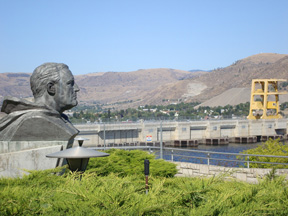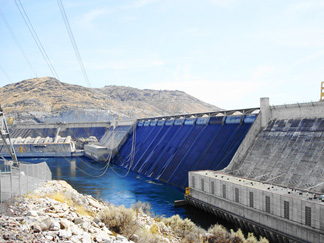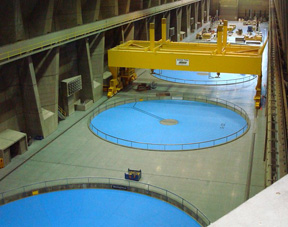The Grand Coulee Dam: The mightiest thing built by man
LeRoy W. Hooton, Jr.
Roll on, Columbia, roll on
Your power is turning our darkness to dawn
So roll on, Columbia, roll on
- Woody Guthrie
|
In late August, traveling in eastern Washington west of Spokane on U.S Highway 2 enroute to the Grand Coulee Dam, the view is of rolling hills covered with dry farm-wheat fields. Along the 90 mile trip are small farms with tractors pulling combines harvesting the wheat. One would not think of temperatures near 100 degrees this far north, but several days before, the temperature reached near the century mark. Actually, this eastern region of the state is considered desert with annual precipitation ranging from 12-14 inches. For several miles along a segment of the highway there were signs of a recent prairie fire, scorching the earth black for as far as the eye can see on either side of the road.
At the small town of Wibur, travel continues onto State Highway 273 for the last 20 miles before reaching the geologically formed Grand Coulee (coulee: derived from the French word for valley or drainage zone). In the distance is a reservoir of deep blue water. Continuing to drive, the largest dam structure and hydroelectricity generation facility in the U.S., and fourth largest in the world, come into full view. Built by the Bureau of Reclamation, the huge Grand Coulee Dam took 12 million cubic yards of concrete to construct, and its hydroelectric generators produce 6,809 megawatts of electrical power. Also, it's one of the largest irrigation reclamation projects in the U.S. The irrigation component of the Columbia Basin Project contemplates over one-million acres of reclaimed land. Currently 550,000 acres are being irrigated by project water.
The head waters of the Columbia River upstream of the Grand Coulee Dam begin in the Canadian Rockies. Major tributaries within the U.S. are the Kootenai, Pend Oreille, Spokane, Wenatchee, Yakima, Willamette, Deschutes, John Day and the Snake. It is the largest river in the western U.S. with a watershed area of 259,000 square miles (including Canada). The mean instantaneous maximum discharge at the Canadian international boundary during the snowmelt season is 269,000 cubic feet per second. The average annual flow volume at the Grand Coulee Dam is 79 MAF. The Columbia River flow at the outlet to the Pacific Ocean is 198 MAF. To gauge how huge this flow is, the Colorado River watershed is nearly the same area, but only yields a volume of 15 MAF – just 7.6 percent of the Columbia.
|
The history of the Grand Coulee Dam is documented in a 30 minute film shown at the Visitors Center. The story of the dam has all of the characters found in a melodrama, consisting of conflicting local interests and politicians, the President of the United States and a folk singer. Their roles in the melodrama are intertwined with the building of what some believed at the time as the Eighth Wonder of the World.
Local interests in eastern Washington were divided on the type of project to build. There were two plans under consideration and bitterly argued for 16 years:
- The gravity system would divert water out of the Columbia River upstream of the Grand Coulee site, which would then flow by gravity in an irrigation canal to the farmers. This option did not have electrical generation that would compete with the Washington Water Power Company located in Spokane. The power company supported the gravity system and orchestrated the opposition.
- The second option required a high dam at the Grand Coulee site with the generation of electricity to pump water out of the Columbia River to an irrigation canal to the farmers. This option was favored by farmers and pro-public power advocates.
After years of acrimony, the decision was made to adopt the pumping option and construct the Grand Coulee Dam with federal participation and public power. The deciding factors included federal funding of the project, more reclaimed land, a large block of electricity to stimulate economic growth for the region and power revenues that would help repay the cost of the project.
In 1933, President Roosevelt authorized a smaller version of the project as a Public Works Administration project (In 1943 the current 550-foot-high dam was approved). Work began under the direction of the Bureau of Reclamation on July 16, 1933 and it was completed in January 1942. The last of the original 18 generators were installed in 1951. Between 1966 and 1974 the dam was enlarged and the Third Powerhouse added. Again in the 1980s larger generators were installed, bringing the average power generation to 21 billion kilowatt hours per year.
In 1941, the federal government hired folk singer Woody Guthrie to help them gain support for construction of dams on the Columbia. Guthrie spent a month in the Columbia Basin and wrote 26 songs. “Roll on, Columbia,” became the signature song to rally support for the federal government's Columbia Basin Project. He was paid $266.66 for his talent. At this point in time Guthrie was relatively unknown. His career was boosted by his Columbia River songs and he later became famous. In 1987, “Roll on, Columbia” became the official song of the state of Washington.
|
The construction of the Columbia River Project and the Grand Coulee Dam has caused environmental and cultural impacts to the river system. Paul C. Pitzer, author of the book “Grand Coulee: Harnessing a Dream,” wrote, “…through the first half of the 20th century, dam builders and irrigation backers saw their work as promoting conservation. To them, taming the rivers, stopping erosion and floods, and reclaiming land outweighed any harm that might follow, and they focused on the promise of power and prosperity...The challenge now is to find a way to accommodate the works of the past with the new visions of the future.”
The hydroelectric generators at Grand Coulee continue to provide electricity to the growing Pacific Northwest. From 1994 through 1998 generation averaged 22.6 billion kilowatt-hours each year. Today this generation capacity provides a large share of the power requirements of this region. Electricity from just the Third Powerhouse alone is sufficient to furnish the power needs for the cities of Seattle and Portland. As Woody Guthrie sang:
And on up the river is Grand Coulee Dam
The mightiest thing ever built by man
To run the great factories and water the land
So roll on, Columbia, roll on


